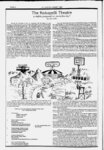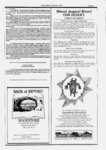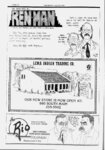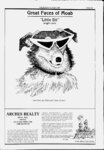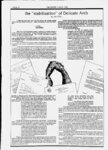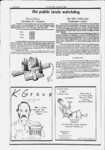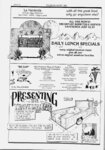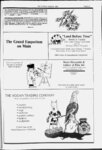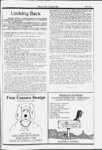| OCR Text |
Show THE ZEPHYR AUGUST 1990 PAGE 20 from the sierra club Multiple Use, Orwell, and Wilderness by Lance Christie balance among these multiple uses Is the dMtailt human task that supports "sustainability. In practice, what multiple use management actually looks Uks Is a mosaic of uses, a sort of complex zoning system. Some areas are surrendered to a single use, becadse It has an outstanding value at that place compared to other values. Thus, we find mines permitted that fence off many acres of land and tear It up, completely eliminating grazing, wildlife, recreation, watershed and other multiple use values, at least until the mine Is reclaimed at the end of Its life (which Is supposed to happen but rarely does, according to vehicle use. the Government Accounting Office). Other areas are designated for Still others are held to have outstanding wilderness values. And what does "outstancflng wilderness values do to multiple use? Lef s take our list: (1) Watershed - preserved and maintained by wilderness designation, since mechanized disturbances are not allowed. (2) Wildlife - preserved and maintained by wilderness designation, since mechanized disturbances are not allowed. Hunting continues In wilderness areas the same as before designation. Since the area has to be roadless to qualify for designation as wilderness, the hunters were on foot or horseback before and are stIIL (3) Grazing - continues as before. In practice as well as law. The cows were being grazed In a roadless area before wilderness designation, so they still are, by the same means. As I have previously pointed out, grazing has not been reduced or eliminated In wilderness areas designated to date. There Is a movement afoot to eliminate grazing abuses on public lands, but this has nothing to do with, or to gain from, wilderness designation. (4) Minerals - when added to the Wilderness Preservation System, the area Is closed to new mineral claim filings. Holders of existing claims can develop them and gain access, Including roads, to a commercially viable mine. They do confront a greater burden of proof than In patenting lands. As I have noted previously, In Utah no area In Hit. 1500, Rep. Owens' 5.1 million acre BLM wilderness proposal. Is more than seven miles from an existing road. With today's computerized slant drilling technology, It would be cheaper to explore under our rugged roadless areas from axlsllng roads than to blast new ones Into them. As a result, I argue that no oil and gas exploration opportunities are foregone by designation the 5.1 million acres Mr. Owens proposes as wilderness. (5) Timber -- Commercial timber harvesting Is eliminated areas In the Wilderness Preservation System, at least In theory. "Salvage cuts from burned areas using helicopters, horses etc., are posable. In most BLM lands In Utah, particularly In Mr. Owens proposal, commercial timber resources do not exist (6) Recreation - Mechanized recreational access to wilderness areas Is forbidden. Use of "necessary medical prostheses (read "wheelchairs) Is allowed. So Is access by foot yours or your animals or your guides animals. Gukflng tourists Into or through wilderness areas Is a potentially lucrative profession for people who know the land, providing an opportunity to educate visitors on local history and values. (7) Archaeological -- It Is the general opinion of archaeologists that resources are preserved by keeping roads away from them. Apparently, pothunters and vandals are not off-ro- ad Every day we read articles quoting people opposing wilderness designation because all public lands should be left open for "multiple use, Instead of being designated as wilderness, allegedly a "single use. Im not sure whether this viewpoint Is the product of clever propaganda artists or Ignorance. As a fan and student of the multiple use concept for public lands management, I know that wilderness Is a multiple use designation with some special provisions. There are a lot of special situations where exceptions apply, but In general you have the same multiple uses In wilderness public lands as elsewhere on public lands, but you cant pursue these uses with a mechanized conveyance (except a wheelchair). It appears that we the folks arguing against wilderness are for keeping roadless public lands accessftMe to speculative mechanized "development" In service of a single use which profits particular private parties (with the government commodity-extractidie-hard capitalist, I dont think there Is anything morally wrong with getting a cut). As a folks accuse the environmentalists of being that However, when the to lock are the who "elitists public lands for a single use, the pot Is calling the up trying kettle black. The way "multiple use gets used In the wilderness debate keeps reminding me of George Orwell. George Orwell was a British novelist best known for his works Animal Farm and 1984. In 1984 Orwell presented a totalitarian future world controlled by "Big Brother. The dictators of the work! used drugs and a propaganda technique known as "Newspeak to keep the people confused and docile. The way "multiple use gets used as a label by wilderness opponents Is a study in Newspeak as Orwell conceived It Some of Big Brother's slogans were: "War Is peace and "Freedom Is slavery. Perhaps we can now add: "My single use for private profit Is multiple use while your multiple uses for public profit Is single use. The concept of "multiple use management of the public lands was originated by Gifford Plnchot Mr. Plnchot was three-ter- m Republican governor of Pennsylvania, and established the U.S. Forest Service under Republican President Theodore Roosevelt Under these Republicans who Invented the multiple use concept the first wilderness area was designated (the Gila in New Mexico). President Teddy Roosevelt and Gifford Plnchot were conservatives and conservationists. In their time, they confronted the wastefulness of the "great barbecue of the Wests resources, and foresaw that consuming resources as If there were no tomorrow would Insure there wouldn't be s tomorrow. Their conservationist philosophy emphasized development and management of resources with an eye to the future - to "sustainability. If "land Is money, as most wilderness opponents would sgree, then It should be managed conservatively, providing for our own and our childrens futures. As Amory Levins observes, you cant develop your checking account by constantly making withdrawals and never making a deposit The Organic Act of the U.S. Forest Service and the Federal Land Planning and Management Act (FUPMA) of the Bureau of Land Management dfroet these agencies to manage their lands under a multiple-us- e concept The law defines this concept as balancing various uses of the land - watershed, wildlife, grazing, minerals, timber, recreational, archaeological, scientific - to the end of restoring and maintaining ecological health so that the land can provide these various values on a sustained yield basis. FLPMA Instructs the BUM to limit use of damaged lands In order to restore them to foil productive health. This policy directly reflects Gifford Plnchofs thinking. Plnchot was no "deep ecologist He definitely thought In terms of managing public lands, not leaving them alone, and of managing them to the benefit of homo sapiens. Plnchofs management concepts are compatible with the Mormon doctrine of man's stewardship responsibility to the earth. Arne Naess's Deep Ecology, by contrast argues that the Idea of man managing nature Is exactly the hubris that got Satan thrown out of heaven, and that human beings have no greater or lesser standing In the community of creatures than any other, viruses and louseworts Included. Uke any management philosophy, the multiple use concept has built-i- n problems -although nothing like those you encounter trying to figure out how to Implement Deep Ecology principles. One problem Is that multiple use cannot mean "everything, all the time, everywhere. Too much depletion of forage by wildlife or cattle damages watershed and fisheries, and Impairs land productivity through loss of topsoil. Mineral production activity tends to displace other uses In the vicinity of the operation. Motorized recreatlonlsts and cattle dont ist comfortably In the same place at the same time, and so on. Striking a ve antl-wlldem- ess non-wlldem- ess fond of walking. (8) Scientific - Presumably, this value Is enhanced by wilderness designation. Intact ecosystems are getting rarer every day, while damaged ones are easy to find. Thus, In our list of eight multiple use values, wilderness Is held to enhance or preserve four, have no effect on one, limit two, and eliminate one. In a pattern of multiple uses management emphases, we logically expect that areas which were outstanding In wildlife, watershed, recreation, archaeological, and scientific value; but limited In mineral, motorized recreation, and timber harvest values would be candidates for multiple-u- se management as wilderness. Guess what! That Is exactly the basis for the Utah Wilderness Coalitions 5.1 million acre Utah BLM wilderness proposal, which Representative Owens has Introduced as H.R. 1500 In Congress. This Is precisely 94 of Utah's land area, less than a "tithe." The Utah Wilderness Coalition (32 environmental and related groups) and Representative Owens welcome debate, on a basis, of what multiple use values are present In each unit and whether the public Interest In multiple use values would be best served, In balance, by adding the unit to the Wilderness Preservation System. The UWC has had a small army of volunteers assessing the areas In Its proposal for several years. The UWC Is ready to debate the wilderness Issue within the multiple use frame of reference, complete with slides snd geologists' reports. From the use of Orwellian Newspeak and various misrepresentations or mythologies about wilderness by wilderness opponents, It seems the opposition Is not so confident non-motori- zed unlt-by-u- nlt Lance Cristle Is Chairman of the Canyonlands Group of the Utah Sierra Club, and Secretary of the Board of Directors of the Southern Utah Wilderness Alliance. Both organizations are members of the Utah Wilderness Coalition. For Information about these or Jack Campbell at 259-51organizations, call Lance at 259-5095 15. co-ex- PACK CREEK RANCH Restaurant Open Daily 6 PM - 10 PM OUR DINNER MENU INCLUDES BBQ Selections New York Steak CurryFish of the Day Blackened Orange Roughy French Pepper Steak Vegetable Plate Roast Cornish Game Hen Tournedos of Beef Prime Rib Daily Horseback Rides At The Ranch For Information or Reservations Phone (801) 259-5505 |



